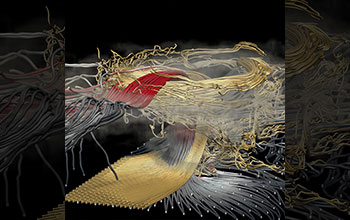Multimedia Gallery
Streamwise vorticity in a supercell thunderstorm
This simulation shows a storm that has spawned a tornado. The scene illustrates how a vortex ring forms when a strong updraft punches into the stable stratosphere, causing the surrounding air to curl downward. Such simulations give researchers insights on the conditions that are likely to herald the development of a tornado.
The image compares variables from the dataset of the hypothetical thunderstorm. The plot shows vortex lines--the gold streamlines modeled from vorticity--compared to wind velocity as gray streamlines with red representing highest speed values.
In a real storm, you can see the clouds billowing upward and corkscrew striations in the rotating cloud, but the relationship between the wind and rotation isn't exactly clear. Plots like this help to illuminate this relationship, giving a better sense of how the vorticity in the environment is tilted, stretched and intensified in the updraft to make the storm rotate. The image illustrates how vorticity in the environment aligns with the winds feeding into the storm to enhance storm rotation.
Improved forecasting and early warning systems have dropped the death toll of
tornadoes significantly over the past few decades. But they remain a very real threat
to lives and property, especially across the swath of the South-Central U.S. known as "Tornado Alley." Researchers at the University of Oklahoma and the University of Texas at Austin have developed highly-detailed simulations that reveal the complex inner workings of thunderstorms in order to better predict when tornadoes will emerge.
This research was supported by National Science Foundation (NSF) grant IIIS 07-46816. The visualization is a still from the film "Simulating Vorticity in a Supercell Thunderstorm," which can be viewed on the Livescience website Here. It was produced using the Texas Advanced Supercomputing Center's (TACC) Stampede computing system. Stampede is funded by NSF through grant ACI 11-34872. (Date of Image: September 2013)
Credit: Greg Foss, Texas Advanced Computing Center, University of Texas at Austin
Images and other media in the National Science Foundation Multimedia Gallery are available for use in print and electronic material by NSF employees, members of the media, university staff, teachers and the general public. All media in the gallery are intended for personal, educational and nonprofit/non-commercial use only.
Images credited to the National Science Foundation, a federal agency, are in the public domain. The images were created by employees of the United States Government as part of their official duties or prepared by contractors as "works for hire" for NSF. You may freely use NSF-credited images and, at your discretion, credit NSF with a "Courtesy: National Science Foundation" notation.
Additional information about general usage can be found in Conditions.
Also Available:
Download the high-resolution JPG version of the image. (8.1 MB)
Use your mouse to right-click (Mac users may need to Ctrl-click) the link above and choose the option that will save the file or target to your computer.

